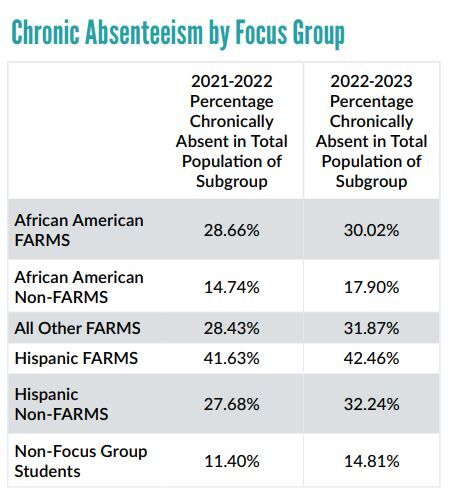Chronic absenteeism surged nationally during the pandemic, and Montgomery County’s public school system didn’t escape that trend.
During the 2018-19 school year, the rate of chronic absenteeism was at just under 20%. In the 2022-23 school year, the overall rate of chronic absenteeism jumped to 27%. In raw numbers, that translates to about 43,000 students missing more than 10% of the 180 days of a school year.
According to data from MCPS, the rate of absenteeism among high school students during the last academic year hit nearly 36%, and the rate for pre-K age students hit 45% — a jump of 14% over the 2018-19 school year.

Damon Monteleone, the school system’s associate superintendent, said it is launching a number of initiatives to reverse the trend.
The first, he said, will be a “qualitative root cause analysis” of why students aren’t coming to school, including a look at barriers to attendance. He also said there would be school-based “planning, monitoring and student intervention system” in place to spot trends faster.
Finally, he said, there will be an expansion of efforts like the one involving the Montgomery County State’s Attorney’s Office, which provides teams that work individually with students to provide support aimed at getting them back to school.
Data also shows that low-income students have higher rates of chronic absenteeism, and that Black and Hispanic students have higher rates of chronic absenteeism than their peers.

Monteleone said some students “do not see themselves in their school community. They may not feel welcome, and they may not have a sense of belonging.”
Steven Neff, director of Pupil Personnel and Attendance Services for MCPS, said “All schools are focusing on school culture and climate and student well-being goals” because “both have a direct impact on student attendance.”
Neff also explained that students have provided feedback, including that they have other responsibilities at home: “They have to take care of younger siblings, they might have to work.”
Both Monteleone and Neff emphasized that the student well-being teams formed to address student mental health will play a role in addressing issues around student attendance.
When asked about what students think, Montgomery County Student Member of the Board of Education Sami Saeed said, speaking as an individual and not as a board member, “I think that there should be more student accountability” for maintaining attendance, but he said there should not be a return of a policy that didn’t take into account student’s circumstances.
Having a rigid policy that would deny a student credit based on attendance alone is a “terrible policy,” he said. “There has to be a balance there.”
Aug. 28 is the first day of classes in Montgomery County.








